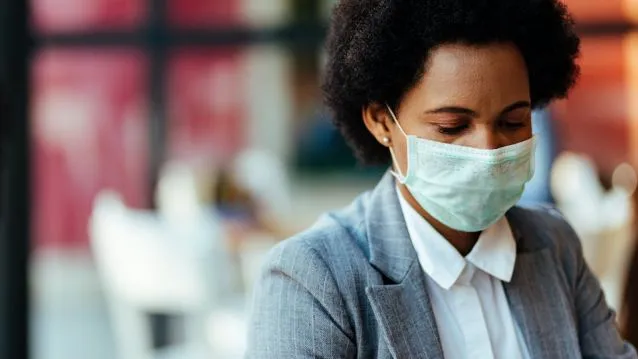Although that bandana on your face certainly looks cool, it doesn’t really cut it when it comes to coronavirus. Since the inception of Covid-19, the Centers for Disease Control and Prevention in the U.S. have recommended Americans wear face masks to stop the spread. But, since there aren’t enough medical-grade masks to meet the demand, many Americans have chosen to sew their own fabric masks or use a bandana. Now, experts weigh in on the top face mask picks to clear up the debate once and for all.
Until now, there have been no concrete guidelines for masks
Since the beginning of the pandemic, the rule of thumb has been, some protection is better than none. It seems that the pathogen responsible for coronavirus is found mostly in respiratory droplets that are sprayed by infected people while talking, coughing, sneezing, and even simply breathing. But now a new study, published in the scientific journal Physics of Fluids, reveals how the construction and materials of a face mask can affect its usefulness. Current masks range from hand-sewn and folded bandanas to surgical masks and N95 respirators. Masks help lessen the risk of cross-infection through respiratory droplets. However, until now, there hasn’t been any precise guidelines for mask materials and designs that prove most effective to ward off the spread of coronavirus.
Since N95 respirators, although excellent protection, have not been available to the general public, only to frontline workers, this mask is off the table when it comes to proper material and design. Instead, we’ll focus on folded masks, bandanas, handmade material masks, and surgical masks.
Folded masks and bandanas
To test the masks, researchers used a fog/smoke machine to create trace particles for the visual study. Respiratory jets expelled a liquid made of distilled water and glycerin. Researchers discovered that loosely folded masks, which consisted of a folded cotton handkerchief created via instructions recommended by the U.S. Surgeon General, were practically ineffective against even the smallest particles. Noticeable droplets leaked through the mask material. Researchers also observed a small amount of moisture escaping from gaps on the top edge of the mask between the nose and the material. And these droplets seemed to stay suspended in the air until movement occurred.
Researchers also tested a single-layer bandana-style mask, which proved to be even less effective in preventing droplets from escaping. Meanwhile, the World Health Organization (WHO) acknowledges that fabric masks alone cannot provide an adequate level of protection. Therefore, a minimum physical distance of at least three feet must be maintained from others at all times.
Stitched homemade masks
Researchers then examined a homemade mask that was sewn together using two sheets of cotton fabric — with 70 threads per inch. What they found was that the mask was able to stop the forward motion of the droplets almost completely. In addition, there was minimal leakage through the material. However, leakage did occur between the nose and the mask, via a gap along the top edge. It was determined that the most effective homemade masks fit well and are constructed with two layers, stitched together of quilting cotton. But it’s important to note that if you choose to make your own masks, the most effective are made of a high-quality fabric that’s woven tightly. Plus, the design should provide a good seal along the edges — without feeling uncomfortable.
Surgical masks
Surgical masks or medical masks, are looser-fitting and disposable. They protect your mouth and nose from coming in contact with splashes, sprays, or drops of moisture that may contain pathogens. These masks are ideal for filtering large particles, suggests the Mayo Clinic. Originally, surgical masks were hard to come by, but since the onset, more have become available to the general public. Dr. Teresa Amato, director of geriatric emergency medicine at Northwell Health, told Healthline that surgical masks are probably the most comfortable to wear since they’re lightweight and provide good protection.
The takeaway
- Leave the folded handkerchief and bandana at home. It’s not that they don’t offer some protection — compared to an uncovered cough — it’s just that protection is very minimal.
- Homemade stitched masks are extremely effective. However, if you decide to make your own, make sure to use two pieces of tightly woven cotton, on top of each other, such as quilting fabric or cotton sheets. In addition, make sure the mask fits tight enough to close gaps, but not too tight that it creates pain. For instructions, visit the CDC.
- Surgical masks are lightweight and can filter out large particles. They provide excellent protection against large-particle type droplets. But keep in mind, they’re not meant to filter inhaled small particles effectively.
Although you are wearing a mask to protect others, you are also wearing a mask to protect yourself. The more Americans wearing masks, the lower the transmission rates. And that also means the faster this pandemic comes to an end. If you have an aversion to wearing a mask, hopefully you understand that masks protect vulnerable people like the elderly and those with underlying medical conditions. Remember, one in three people who are infected with Covid-19 do not show symptoms. So, masks are crucial.
-Katherine Marko

